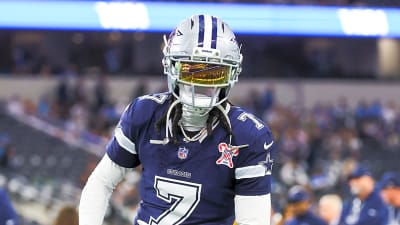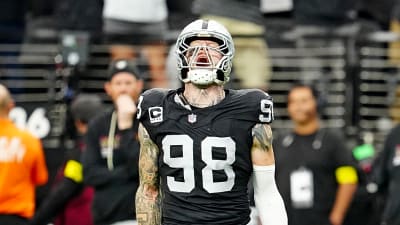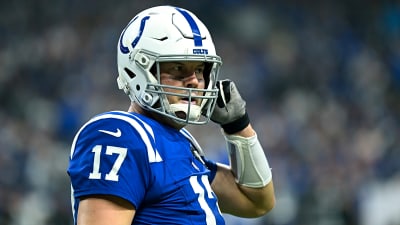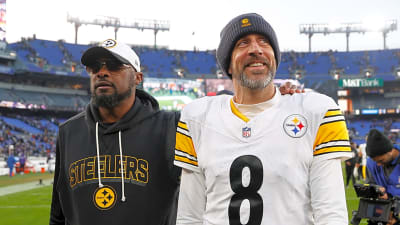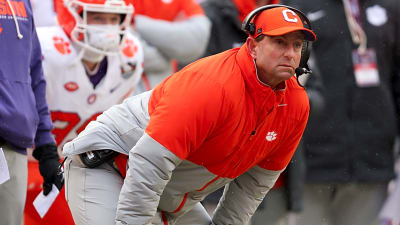- Home
- Quizzes
- My Quiz Activity
- Newsletters
- MY FAVORITES
- Add Sports/Teams
- SPORTS
-
NFL
- NFL Home
- Arizona Cardinals
- Atlanta Falcons
- Baltimore Ravens
- Buffalo Bills
- Carolina Panthers
- Chicago Bears
- Cincinnati Bengals
- Cleveland Browns
- Dallas Cowboys
- Denver Broncos
- Detroit Lions
- Green Bay Packers
- Houston Texans
- Indianapolis Colts
- Jacksonville Jaguars
- Kansas City Chiefs
- Las Vegas Raiders
- Los Angeles Chargers
- Los Angeles Rams
- Miami Dolphins
- Minnesota Vikings
- New England Patriots
- New Orleans Saints
- New York Jets
- New York Giants
- Philadelphia Eagles
- Pittsburgh Steelers
- San Francisco 49ers
- Seattle Seahawks
- Tampa Bay Buccaneers
- Tennessee Titans
- Washington Commanders
-
MLB
- MLB Home
- Athletics
- Arizona Diamondbacks
- Atlanta Braves
- Baltimore Orioles
- Boston Red Sox
- Chicago White Sox
- Chicago Cubs
- Cincinnati Reds
- Cleveland Guardians
- Colorado Rockies
- Detroit Tigers
- Houston Astros
- Kansas City Royals
- Los Angeles Angels
- Los Angeles Dodgers
- Miami Marlins
- Milwaukee Brewers
- Minnesota Twins
- New York Yankees
- New York Mets
- Philadelphia Phillies
- Pittsburgh Pirates
- San Diego Padres
- San Francisco Giants
- Seattle Mariners
- St. Louis Cardinals
- Tampa Bay Rays
- Texas Rangers
- Toronto Blue Jays
- Washington Nationals
-
NBA
- NBA Home
- Atlanta Hawks
- Boston Celtics
- Brooklyn Nets
- Charlotte Hornets
- Chicago Bulls
- Cleveland Cavaliers
- Dallas Mavericks
- Denver Nuggets
- Detroit Pistons
- Golden State Warriors
- Houston Rockets
- Indiana Pacers
- Los Angeles Clippers
- Los Angeles Lakers
- Memphis Grizzlies
- Miami Heat
- Milwaukee Bucks
- Minnesota Timberwolves
- New Orleans Pelicans
- New York Knicks
- Oklahoma City Thunder
- Orlando Magic
- Philadelphia 76ers
- Phoenix Suns
- Portland Trail Blazers
- Sacramento Kings
- San Antonio Spurs
- Toronto Raptors
- Utah Jazz
- Washington Wizards
-
NHL
- NHL Home
- Anaheim Ducks
- Boston Bruins
- Buffalo Sabres
- Calgary Flames
- Carolina Hurricanes
- Chicago Blackhawks
- Colorado Avalanche
- Columbus Blue Jackets
- Dallas Stars
- Detroit Red Wings
- Edmonton Oilers
- Florida Panthers
- Los Angeles Kings
- Minnesota Wild
- Montreal Canadiens
- Nashville Predators
- New Jersey Devils
- New York Islanders
- New York Rangers
- Ottawa Senators
- Philadelphia Flyers
- Pittsburgh Penguins
- San Jose Sharks
- Seattle Kraken
- St. Louis Blues
- Tampa Bay Lightning
- Toronto Maple Leafs
- Utah Mammoth
- Vancouver Canucks
- Vegas Golden Knights
- Washington Capitals
- Winnipeg Jets
- NCAAF
- NCAAM
- Olympics
- Boxing
- Entertainment
- Lifestyle
- Golf
- MMA
- Soccer
- Tennis
- Wrestling
- Sports Betting
- More Sports
- RESOURCES
- My Account
- YB on Facebook
- YB on Twitter
- YB on Flipboard
- Contact Us
- Privacy Policy
- Terms of Service
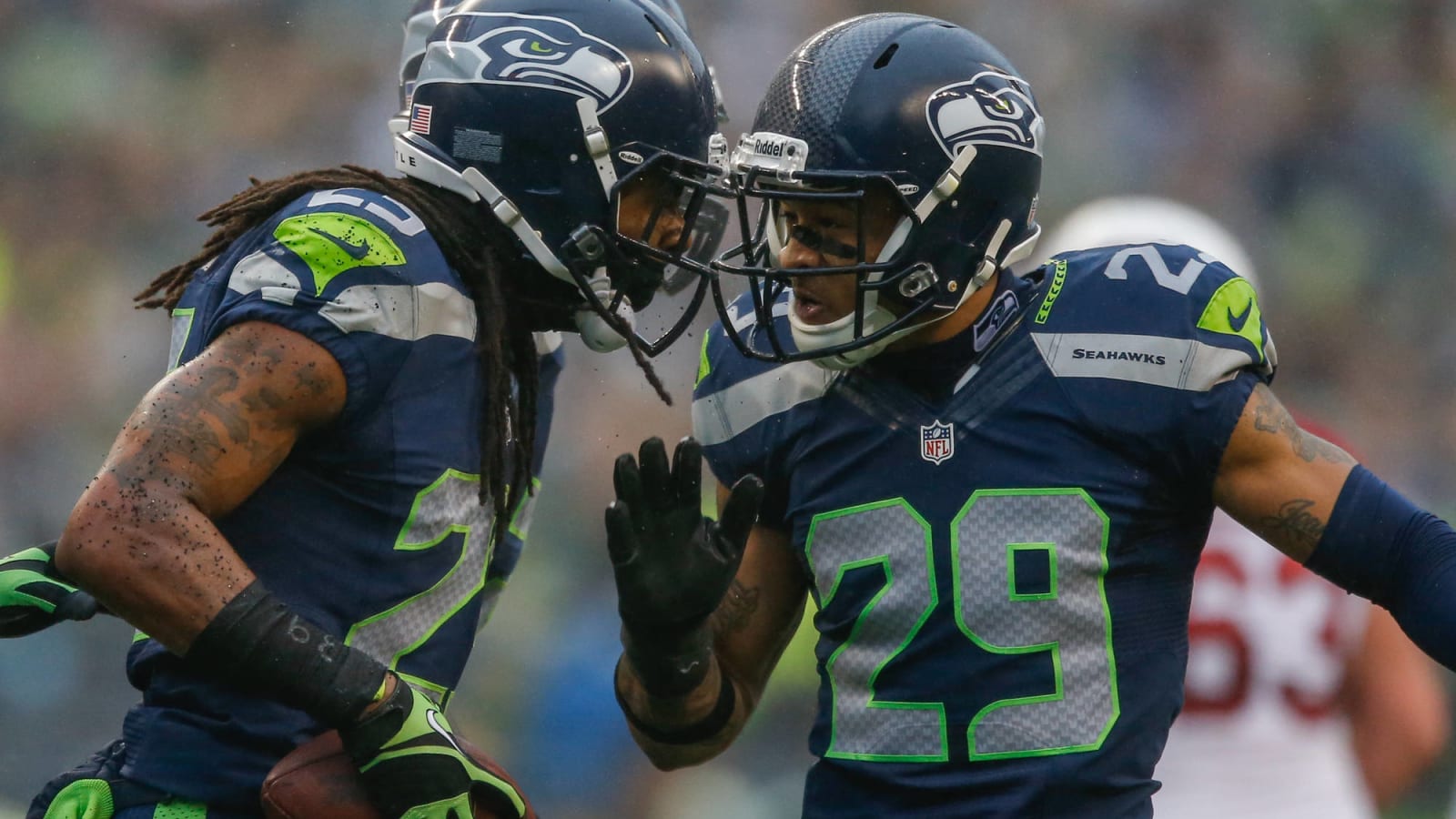
Every NFL team's best position group of all time
As NFL teams survey their depth at respective OTAs and minicamps, here is a reminder of roster-construction mastery executed by each franchise. These are the best position groups each team has ever fielded.
Arizona Cardinals: receiver trio gives Kurt Warner new life
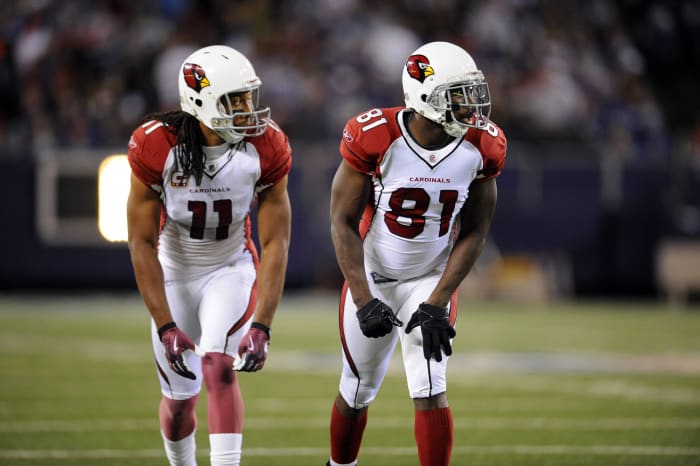
After uninspiring years followed his second MVP season, Warner reshaped his career in Arizona. Helping him do it: Larry Fitzgerald and Anquan Boldin, one of this century's top receiving tandems. Fitzgerald, Boldin and Steve Breaston each surpassed 1,000 yards in 2008 (even WR4 Jerheme Urban nearly got to 500), helping a 9-7 Cardinals team to Super Bowl XLIII. Counting the playoffs, Fitzgerald finished that year with 19 TDs. After Fitz-Boldin went 1,000-1,000 in their 2009 finale together, Breaston and Early Doucet showed the group's incredible depth in a 51-45 wild-card win.
Atlanta Falcons: Gonzalez, White groom Julio

While the 1977 Falcons deployed the "Grits Blitz" defense that set a record for fewest points ceded in a 14-game season (9.2), Matt Ryan's early-career aerial support had more staying power. Julio Jones' 2011 arrival further ignited an Atlanta attack that featured future Hall of Famer Tony Gonzalez and longtime WR1 Roddy White. That trio combined for 3,479 yards in 2012 and helped the 13-3 Falcons to the Super Bowl precipice. Gonzalez, Jones and White worked together for three seasons and combined for five Pro Bowl honors in that time.
Baltimore Ravens: Ray Lewis and friends

One of the most dominant Super Bowl champions, the 2000 Ravens went five games without scoring a touchdown. Lewis and Co. made that a non-issue. Baltimore's intergalactic defense yielded one touchdown in the playoffs. During the Ravens' breakout stretch, the Lewis-Peter Boulware-Jamie Sharper linebacking corps was the unit's best facet. A versatile four-time Pro Bowler, Boulware registered 15 sacks in 2001. His outside-'backer cohort, Sharper, collected six that year. Lewis went on to only become an all-time great. The Baltimore linebackers' late-'90s/early-aughts work started that rise.
Buffalo Bills: K-Gun's air support

While O.J. Simpson's offensive line had a better name (the Electric Company), the Bills' maximum capabilities came with Hall of Fame receivers in place in the early 1990s. Ex-Packer great James Lofton became an overqualified Andre Reed sidekick after a failed Raiders stay, and the duo helped Jim Kelly's K-Gun offense ignite. Reed and Lofton each made the 1991 Pro Bowl, forming a top-level wideout duo. In that time both Don Beebe and Steve Tasker — Buffalo's WR3 and ace special teamer, respectively — made this a diverse machine that catalyzed the Bills' no-huddle attack for years.
Carolina Panthers: NFC champions' linebacking corps
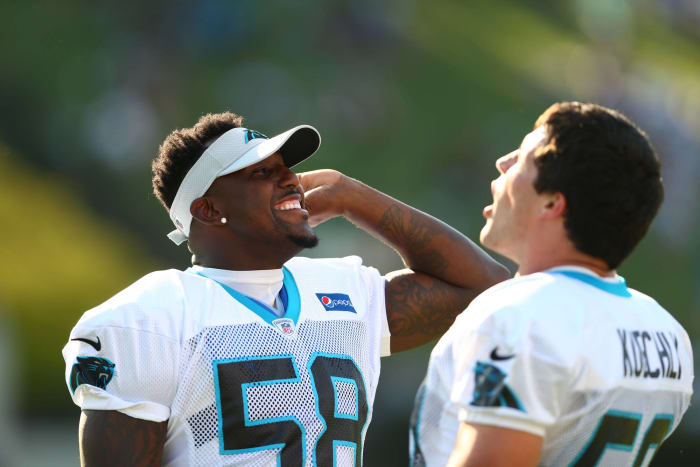
Difficult to overlook one of the NFL's longest-running backfield committees, but the Panthers formed a stellar partnership upon drafting Luke Kuechly in the 2012 first round. Kuechly and outside linebacker stalwart Thomas Davis gave the Panthers one of the best three-down linebacker tandems in recent league annals, and 2015 first-rounder Shaq Thompson learned on the job alongside them for four years. As one of the game's best middle 'backers, Kuechly is Hall of Fame-bound. He and Davis, Carolina's all-time tackles leader, combined for nine Pro Bowls in their seven-year run together.
Chicago Bears: the 46's front four

Buddy Ryan's 46 defense created a monster. The Bears of the mid-1980s featured one of the best defensive nuclei ever. Ends Richard Dent and Dan Hampton and tackles Steve McMichael and William "The Refrigerator" Perry made this mayhem possible. Dent and Hampton are Hall of Famers, and McMichael was twice an All-Pro. The 1984 Bears' 72 sacks remain the NFL standard, and they posted 70 in a strike-shortened 1987 slate. The '85 Bears allowed 10 points in three playoff games; the '86 group was statistically better in the regular season. It wasn't their fault only one title came from this.
Cincinnati Bengals: making life hard on '70s QBs

Assembling an AFC contender in the 1970s was difficult, but the Bengals fared well. One of the catalysts for their early- and mid-'70s success: a stacked secondary. Led by perennial Pro Bowler Lemar Parrish and 15-year Bengal Ken Riley at corner, and three-time Pro Bowler Tommy Casanova at safety, Cincinnati twice made the playoffs and won 10 games three times from 1973-76. They rolled out top-four pass defenses four times from 1972-76. Parrish and Casanova both left in '78, but Riley (zero Pro Bowls despite 65 INTs — fifth all time) stuck around beyond Super Bowl XVI.
Cleveland Browns: two-Hall of Famer backfield
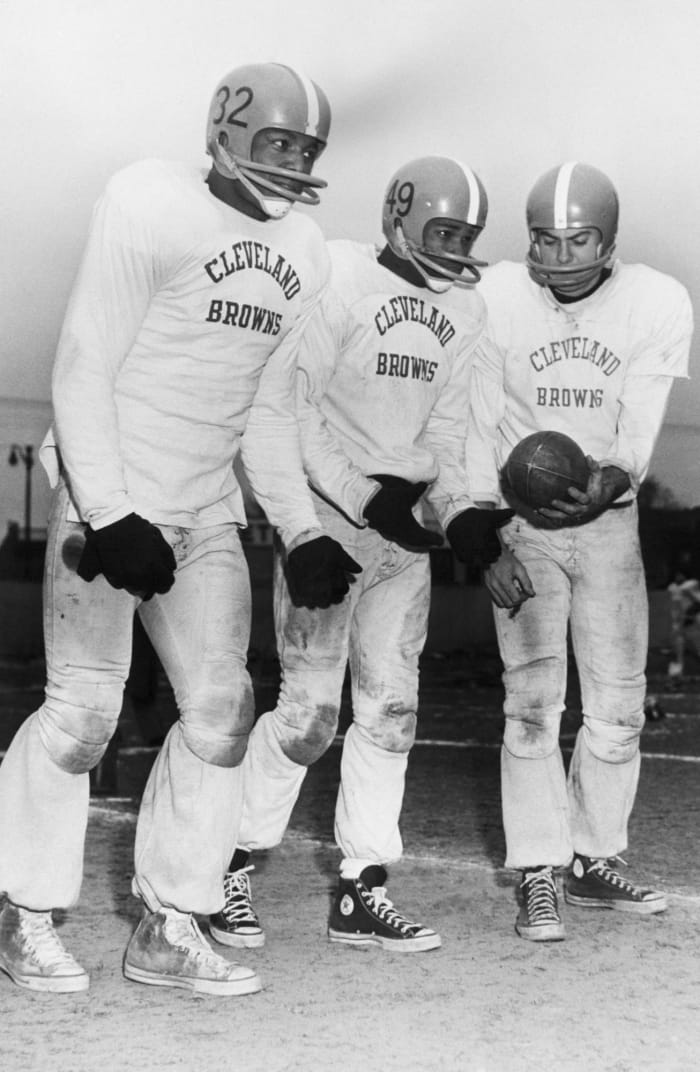
For four years Jim Brown had an elite running mate. A seventh-round 1958 draft pick, Bobby Mitchell provided the outside speed to Brown's indefensible inside onslaughts. Mitchell totaled at least 900 yards from scrimmage in three of his four Cleveland seasons — all ending in Brown rushing titles. Paul Brown preferred to pair his superstar fullback with Heisman winner Ernie Davis, leading to Mitchell being traded to Washington. The Redskins moved him to wide receiver, paving a path to the Hall of Fame. Those four years gave the Browns astounding backfield diversity.
Dallas Cowboys: the Great Wall of Dallas

Blessed with many deep positional arsenals, the Cowboys' best came in the early 1990s via one of the NFL's greatest offensive lines. Emmitt Smith's initial set of blockers included Mark Tuinei, Kevin Gogan, Mark Stepnoski, Nate Newton and Erik Williams — each at least a two-time Pro Bowler. The Cowboys won back-to-back Super Bowls but assembled an even more talented line for their Super Bowl XXX surge. Hall of Fame guard Larry Allen was starting by 1995, and longtime Colt Ray Donaldson covered for Stepnoski's exit. Four of Dallas' five linemen made the '95 Pro Bowl, and Smith won his fourth rushing title in five years.
Denver Broncos: zone-blocking consistency

The Broncos' best lines did not boast the Cowboys' brute strength, but their zone blocking produced success regardless of the running back. Running behind Tom Nalen, Mark Schlereth and Hall of Famer Gary Zimmerman, Terrell Davis glided to a historic stretch in the late 1990s. But Denver's line made 1,000-yard rushers out of lesser Davis successors. Olandis Gary, Mike Anderson, Clinton Portis, Reuben Droughns and Tatum Bell followed suit from 1999-2006. Only Nalen, Denver's center, was a post-Super Bowl-era Pro Bowler. This was one of the most interesting runs by an NFL offensive line.
Detroit Lions: Motor City cover men

Between 1958 and 1967 the Lions employed five Hall of Fame secondary cogs. The first group helped Detroit to three NFL titles in the '50s; the second packed more talent. A holdover from the champions, nine-time Pro Bowl safety Yale Lary finished his career in the early '60s. Fellow Hall of Famers Dick "Night Train" Lane and Dick LeBeau joined him. Although the legendary Lane was better elsewhere, he earned the last of his seven Pro Bowls in Detroit. He and LeBeau sit top 10 all time in INTs (68 and 62), and Lary retired with 50. The '62 Lions won 11 games and carried the No. 1 defense; the Packers foiled their plans.
Green Bay Packers: making the power sweep possible

Just about every group from the 1960s Packers' rosters was in play. But the linemen who turned Jim Taylor and Paul Hornung into stars, ruthlessly executing Vince Lombardi's power sweeps, did plenty to shape the dynasty. Lombardi called seven-time All-Pro right tackle Forrest Gregg the finest player he coached, and fellow Hall of Famers Jim Ringo and Jerry Kramer accompanied him for much of Green Bay's run. Also employing All-Pro Fuzzy Thurston and Pro Bowler Bob Skoronski, the Packers deployed a top-two rushing attack five times from 1961-67. Lombardi's team motored to five NFL titles in those years.
Houston Texans: their current pass rush

Narrowly surpassing the Andre Johnson-DeAndre Hopkins overlap, J.J. Watt working with Jadeveon Clowney (with help from Whitney Mercilus) as passing-down linemen wins out. He of five All-Pro honors and three Defensive Player of the Year trophies, Watt is already one of the NFL's defensive end greats. Clowney mixes in at multiple spots and is one of the game's most complete front-seven players. Often injured at different times, Watt and Clowney finally worked together full time in a 2018 Texans resurgence. Mercilus quietly has three seven-sack slates, also posing as a solid wing man.
Indianapolis Colts: Hall of Famers help extend Unitas' peak

While tough to overlook Peyton Manning's receivers, Johnny Unitas worked with Baltimore icons. Hall of Famers Raymond Berry and Lenny Moore (and steady sidekick Jimmy Orr) were around for the Colts' 1958-59 championships, but as they hit the back ends of their primes, tight end legend John Mackey arrived. By 1963 Unitas had three Hall of Famers and Orr (66 career TDs) at his disposal. Flanker-halfback Moore and chain-moving machine Berry combined for 13 Pro Bowls and were still effective by the time Mackey debuted. This quartet amassed 12 All-Pro honors and kept Unitas humming well into his 30s.
Jacksonville Jaguars: Mark Brunell's receivers
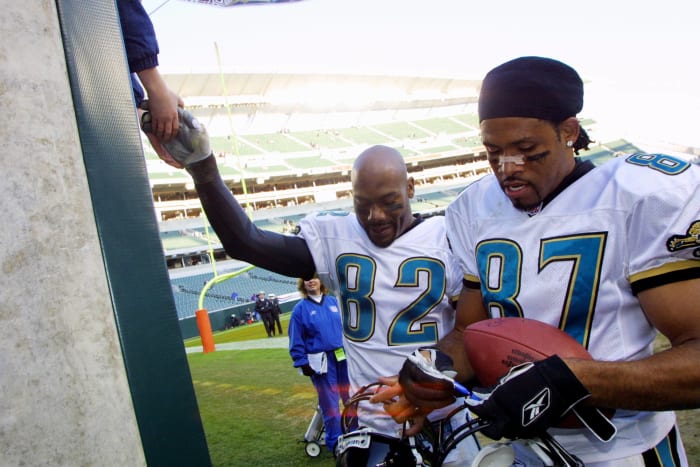
Getting the nod over Fred Taylor and Maurice Jones-Drew, Jimmy Smith and Keenan McCardell worked as a prolific receiver tandem for six years. They combined for 10 1,000-yard seasons in this span, Smith having maybe the best career in Jaguars history and McCardell serving as an overqualified WR2. This duo's time doubled as the Jags' apex, Tom Coughlin's team making four straight playoff brackets and two AFC title games. During Smith's Jags years (1995-05), only Marvin Harrison compiled more receiving yards. McCardell left for Tampa Bay in 2002, helping the Bucs to their first championship.
Kansas City Chiefs: linebackers lead loaded defense

Talentwise, it did not get much better than when Hall of Famers Bobby Bell and Willie Lanier teamed up in Kansas City. A tackling warlord, Lanier was pro football's first black middle linebacker. He joined Bell, among the most gifted linebackers ever, in living on Pro Bowl rosters in the 1960s and early '70s. These two, coupled with 10-year starter Jim Lynch, were the best part of a loaded Chiefs defense (six Hall of Famers) responsible for demolishing the Vikings in Super Bowl IV. Bell and Lanier are arguably the two greatest players in Chiefs history.
Los Angeles Chargers: Air Coryell

Although the Chargers performed a mid-era cast change, swapping in Wes Chandler for John Jefferson, Hall of Famers Kellen Winslow and Charlie Joiner kept Air Coryell rolling. These high-powered trios helped the Don Coryell-engineered Bolts revolutionize the passing game, Dan Fouts' weaponry steering the Bolts to back-to-back AFC title games. Joiner, Jefferson and Winslow comprised the first aerial trio to each exceed 1,000 yards in a season (1980), and Chandler's 1982 (1,032 yards in nine games) remains the NFL's yards-per-game record. NFL passing does not get much better.
Los Angeles Rams: "Fearsome Foursome"
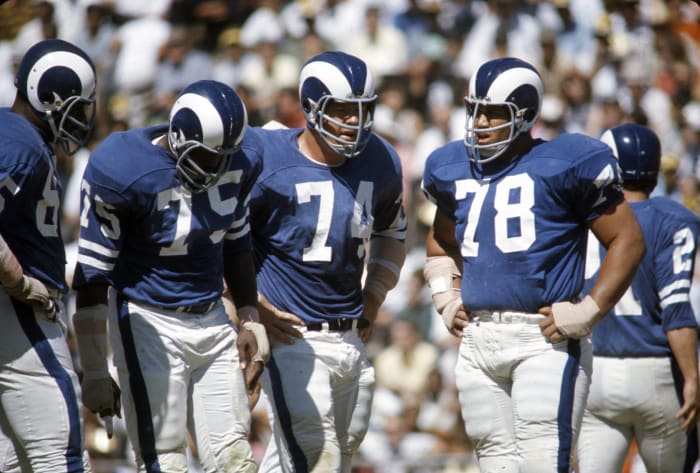
Members of the "Fearsome Foursome" changed, but Deacon Jones and Merlin Olsen — two of the best NFLers ever — anchored it throughout its existence. A matchup nightmare inside, Olsen made 14 Pro Bowls. Jones (and his head slap) ruined many tackles' Sundays and is unofficially credited with 173.5 sacks (which would be third all time). Ends Lamar Lundy and Coy Bacon (two unofficial 20-sack seasons) and tackle Rosey Grier also resided here, with Jones-Olsen-Grier-Lundy being the original quartet. The Rams' relentless pass rush was a big part of their late-1960s and early-'70s success.
Miami Dolphins: ground troops key dynasty
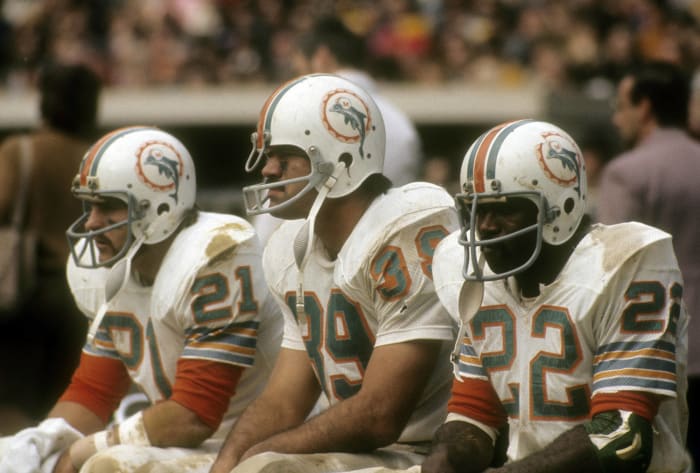
All due respect to the Marks Brothers, this trio is most associated with Dolphin dominance. Larry Csonka and Mercury Morris became the first teammates to surpass 1,000 yards in a season, doing so during the Dolphins' perfect 1972. Jim Kiick, Morris' tailback predecessor, added 521. The Dolphins led the NFL in rushing from 1971-74, going to three Super Bowls. Kiick and Morris both functioned around the Hall of Fame fullback. Playing behind a two-Hall of Famer offensive line, this troika carved up defenses for years. Miami won Super Bowl VIII with seven pass attempts.
Minnesota Vikings: "Purple People Eaters"

The only defensive lineman to win MVP honors, Alan Page joined fellow Hall of Famer Carl Eller, NFL iron man Jim Marshall and Gary Larsen to form the "Purple People Eaters." All were Pro Bowlers. While Fran Tarkenton keyed Minnesota's 1970s success, the defensive line was there longer. A lightning-quick defensive tackle, Page showed a nearly unparalleled interior pass rush. The 1971 MVP is unofficially credited with 173 sacks. He and Eller, an end, combined for 11 All-Pro nods. Marshall's 270 straight starts were a record until 2009 (Brett Favre). Page, Eller and Marshall played in four Super Bowls.
New England Patriots: helping Tom Brady become Tom Brady

Not a Pro Bowler in 2002, '03 or '06, Brady saw his numbers spike in 2007. Trades for Randy Moss and Wes Welker, and a Donte Stallworth signing, led to Brady throwing 50 touchdown passes (after tossing 24 in '06) and piloting the Patriots to 18 straight wins. New England featured two 1,000-yard receivers, with Moss' 23 touchdown catches still the standard and Welker beginning his run as arguably the NFL's slot GOAT. Thrice a 700-yard receiver, Jabar Gaffney was this group's WR4. This foursome spent just one year together, but the Pats kept Moss and Welker for two more seasons.
New Orleans Saints: "Dome Patrol"

One of the deepest positions the modern NFL has seen, the Saints teamed four Pro Bowl linebackers together for seven seasons. Each "Dome Patrol" member — outside rushers Rickey Jackson and Pat Swilling and inside cogs Sam Mills and Vaughan Johnson — made a 1992 Hawaii trip. Forming in 1987, the patrolmen combined for 20 career Pro Bowls. Jackson (128 sacks) is a Hall of Famer, fellow sack artist Swilling was the 1991 Defensive Player of the Year and Mills became one of the great NFL success stories. This group's rise coincided with the Saints' first run of playoff berths.
New York Giants: "Big Blue Wrecking Crew"
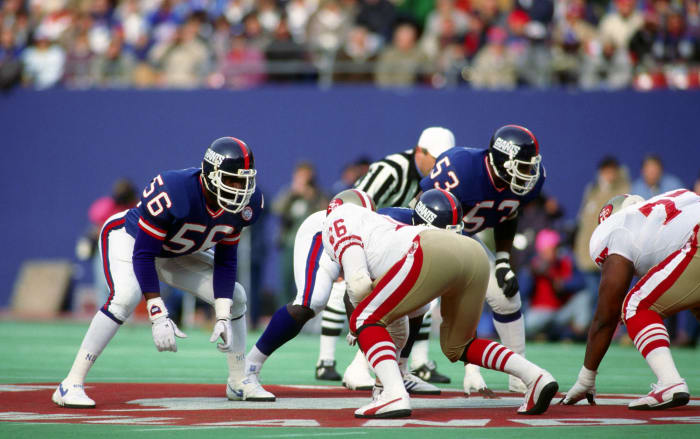
Firmly in the "greatest player ever" conversation, Lawrence Taylor changed football. His unrivaled pass-rushing skill led the Giants to the mountaintop in the 1980s. Taylor had help. Leading forgettable Giants teams for years, Hall of Famer Harry Carson manned middle linebacker during Taylor's wrecking spree. They combined for a cool 19 Pro Bowls. New York's 3-4 defense also featured Carl Banks (1987 All-Pro) as Taylor's counterpart and Gary Reasons inside. Carson was there for the Giants' first Super Bowl in 1986; the other three carried the banner in 1990. This started Bill Belichick's ascent.
New York Jets: "New York Sack Exchange"

Taylor was one reason sack record-keeping began in 1982; the Shea Stadium tenants' defensive line was another. The Jets led the NFL in sacks (by 14) with 66 in 1981, with Mark Gastineau and Joe Klecko unofficially recording at least 20 apiece. While the flamboyant Gastineau and the versatile Klecko were the All-Pros, supporting actors Marty Lyons (the group's only first-round pick) and Abdul Salaam completed the quartet (and one of the best sports nicknames). Gastineau reached his peak with a still-should-be-a-record 22 sacks in 1984; he and Klecko helped the Jets to four playoff berths in six years.
Oakland Raiders: How many Hall of Famers?

For sheer talent, it is hard to rival the Raiders' best group. Between 1971-73, Oakland's starting offensive line housed four Hall of Famers. Hulking right tackle Bob Brown joined the team's Art Shell-Gene Upshaw-Jim Otto left side. For good measure, Hall of Famer Ron Mix stopped through in his final season (1971). Paving space for Daryle Lamonica (and then Ken Stabler), the Shell-Upshaw-Otto-Brown group earned 33 combined Pro Bowl invites (Otto, 10 All-Pros at center). This group faced off in epic playoff battles against the Steel Curtain, with Upshaw and Shell residing on future Raider Super Bowl lines.
Philadelphia Eagles: a tragic what-if
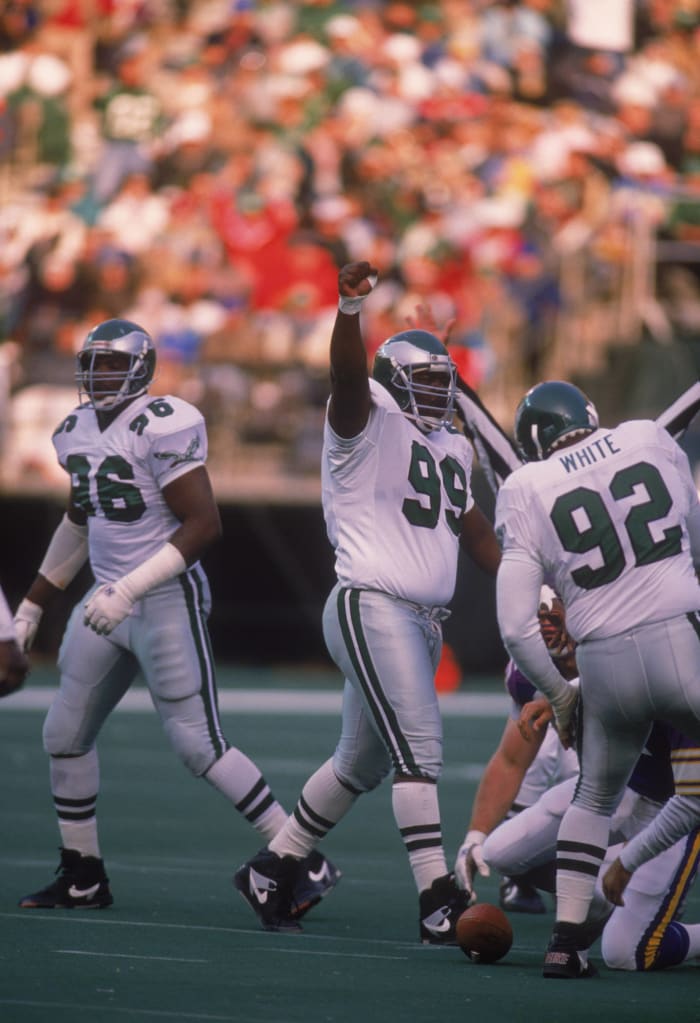
The 1991 Eagles did not make the playoffs, but a dominant defense nearly willed that into existence. Philadelphia placed three defensive linemen — Reggie White, Clyde Simmons and Jerome Brown — on the '91 All-Pro first team. This front played together for five years. White (124 sacks as an Eagle) had stellar sidekicks after Simmons, an end, and Brown, a tackle, joined the legend in 1986 and '87, respectively. Their work helped the Eagles to three NFC brackets from 1988-90 and had the look of a long-lasting coalition. But Brown's 1992 death (and White's 1993 free-agency exit) dashed those hopes.
Pittsburgh Steelers: Steel Curtain's second level
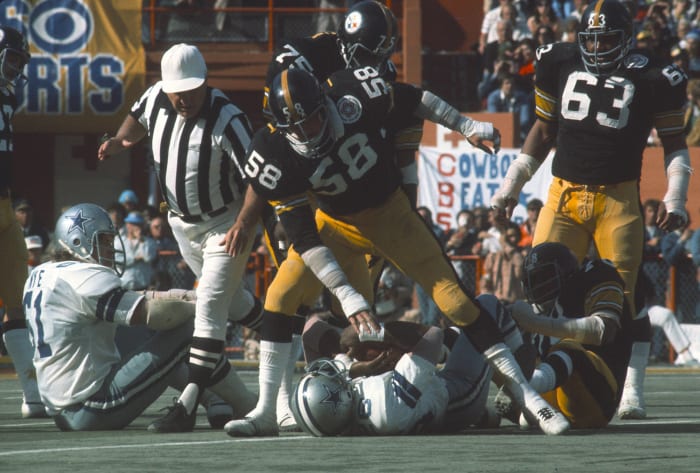
Joe Greene was the Steel Curtain's premier player, but the group operating behind him featured Pittsburgh's best talent array. Jack Ham, Jack Lambert and Andy Russell teamed up for a three-year stretch from 1974-76; the group appeared in seven combined Pro Bowls in that span, one that doubled as the dawn of Pittsburgh's dynasty. Ham has been called the greatest coverage linebacker ever; the technically sound six-time All-Pro intercepted 32 passes (third-most by a linebacker). Lambert (also six All-Pros) served as the Steel Curtain's enforcer. Russell peaked before the Hall of Famers arrived but made seven Pro Bowls.
San Francisco 49ers: QB controversy for the ages

All due respect to the 49ers' "Million Dollar Backfield" of the mid-1950s, two of the game's 10 best quarterbacks played on the same team for six years. And Steve Young was not a pure backup. Joe Montana's injury issues, and Bill Walsh not settling a years-long quarterback controversy, created an unfathomable depth chart. Though both were three-time All-Pros, Montana delivered quarterback masterclasses in the '80s — peaking in an otherworldly '89 season — and was at the controls of the 49er dynasty's zenith. And the apprentice kept the car in high gear in the 1990s.
Seattle Seahawks: "Legion of Boom"

A well-constructed secondary provided the foundation for the Seahawks' apex. Earl Thomas and Kam Chancellor complemented each other, one a rangy safety ideal for modern football and the other an old-school box menace. Richard Sherman, as you may recall, was this unit's hype man. Operating in Pete Carroll's Cover-3, with a revolving door at right cornerback, the lanky cover man patrolled his side as well as anyone during the mid-2010s. Seattle's defense dominated one Super Bowl and did enough to win another, but injuries and team in-fighting separated this famed back line.
Tampa Bay Buccaneers: Warren Sapp gets a running mate

Only nitpicking can reveal weaknesses on the Bucs' early-aughts defenses. Well-stocked on each level, Tampa Bay paired a Hall of Fame defensive tackle with a dynamic edge rusher. Simeon Rice arrived in 2001, after toiling in Arizona for years, and formed an optimal inside-outside duo with Warren Sapp. Rice stepped right in with consecutive 15-sack slates his first two years. Booger McFarland and Greg Spires rounded out the Bucs' D-line, which helped the 2002 champion team form one of the league's greatest defenses. The '02 Bucs scored nine defensive touchdowns, including three in Super Bowl XXXVII.
Tennessee Titans/Houston Oilers: run-and-shoot recipients

This collection featured no Hall of Famers, like various Oiler lines did, but it was deep and helped Warren Moon to Canton. Drew Hill, Ernest Givins, Haywood Jeffires and Curtis Duncan were Moon's top weapons on the Oilers' run-and-shoot offenses. Save for Jeffires, diminutive talents were Moon's chain-movers. Each a Pro Bowler at one point, their legacy remains. The Oilers zoomed to seven straight playoff brackets from 1987-93. In '90, all four wideouts posted at least 750 yards; in '92, three of them made the Pro Bowl. Givins, Hill and Jeffires still sit atop the primary Oilers/Titans' receiving categories.
Washington Redskins: "The Hogs"

Helping the Redskins win three Super Bowls with three quarterbacks, "The Hogs" were the franchise's defining group. "Hogs" version 1.0 featured Hall of Fame guard Russ Grimm and All-Pro tackle Joe Jacoby, opening lanes for John Riggins in Super Bowl XVII (and in his record-setting 1983) and helping Joe Theismann to MVP that year. Both Grimm and Jacoby (and Pro Bowlers Mark May and Jeff Bostic) were on the '87 line that turned Timmy Smith from random running back to Super Bowl record holder. Grimm and Jacoby collected three rings, the last coming in the Redskins' tour de force 1991.
Sam Robinson is a sportswriter from Kansas City, Missouri. He primarily covers the NFL for Yardbarker. Moving from wildly injury-prone sprinter in the aughts to reporter in the 2010s, Sam set up camp in three time zones covering everything from high school water polo to Division II national championship games
More must-reads:
- The best NFL draft picks by state
- Who was the No. 1 NFL draft pick from the year you were born?
- The 'Top-50 all-time NFL rushers' quiz
Breaking News
Trending News
Customize Your Newsletter
 +
+
Get the latest news and rumors, customized to your favorite sports and teams. Emailed daily. Always free!
PRIVACY POLICY EDITORIAL POLICY CONTACT US
ABOUT YARDBARKER TERMS OF SERVICE
Use of this website (including any and all parts and
components) constitutes your acceptance of these
Terms of Service and Privacy Policy.
This site is for entertainment purposes only.
There is no gambling offered on this site.
Gambling Problem? Call 1-800-Gambler.
